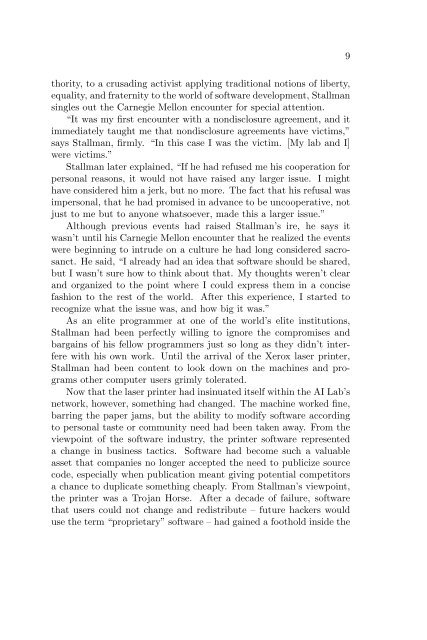Create successful ePaper yourself
Turn your PDF publications into a flip-book with our unique Google optimized e-Paper software.
thority, to a crusading activist applying traditional notions of liberty,<br />
equality, and fraternity to the world of software development, Stallman<br />
singles out the Carnegie Mellon encounter for special attention.<br />
“It was my first encounter with a nondisclosure agreement, and it<br />
immediately taught me that nondisclosure agreements have victims,”<br />
says Stallman, firmly. “In this case I was the victim. [My lab and I]<br />
were victims.”<br />
Stallman later explained, “If he had refused me his cooperation for<br />
personal reasons, it would not have raised any larger issue. I might<br />
have considered him a jerk, but no more. The fact that his refusal was<br />
impersonal, that he had promised in advance to be uncooperative, not<br />
just to me but to anyone whatsoever, made this a larger issue.”<br />
Although previous events had raised Stallman’s ire, he says it<br />
wasn’t until his Carnegie Mellon encounter that he realized the events<br />
were beginning to intrude on a culture he had long considered sacrosanct.<br />
He said, “I already had an idea that software should be shared,<br />
but I wasn’t sure how to think about that. My thoughts weren’t clear<br />
and organized to the point where I could express them in a concise<br />
fashion to the rest of the world. After this experience, I started to<br />
recognize what the issue was, and how big it was.”<br />
As an elite programmer at one of the world’s elite institutions,<br />
Stallman had been perfectly willing to ignore the compromises and<br />
bargains of his fellow programmers just so long as they didn’t interfere<br />
with his own work. Until the arrival of the Xerox laser printer,<br />
Stallman had been content to look down on the machines and programs<br />
other computer users grimly tolerated.<br />
Now that the laser printer had insinuated itself within the AI Lab’s<br />
network, however, something had changed. The machine worked fine,<br />
barring the paper jams, but the ability to modify software according<br />
to personal taste or community need had been taken away. From the<br />
viewpoint of the software industry, the printer software represented<br />
a change in business tactics. Software had become such a valuable<br />
asset that companies no longer accepted the need to publicize source<br />
code, especially when publication meant giving potential competitors<br />
a chance to duplicate something cheaply. From Stallman’s viewpoint,<br />
the printer was a Trojan Horse. After a decade of failure, software<br />
that users could not change and redistribute – future hackers would<br />
use the term “proprietary” software – had gained a foothold inside the<br />
9


